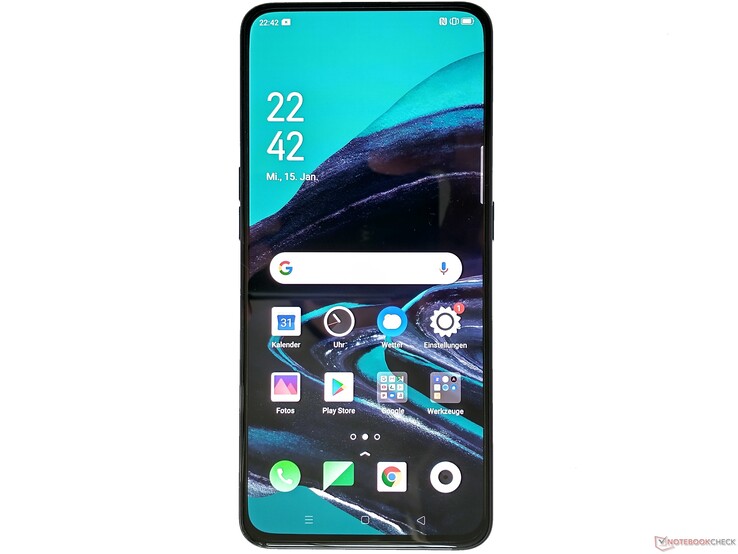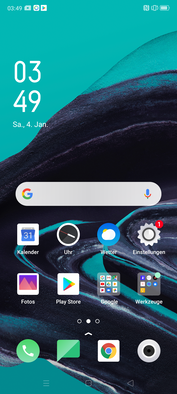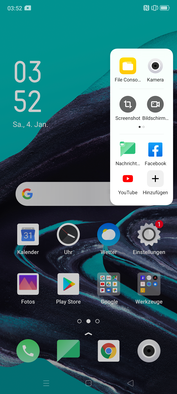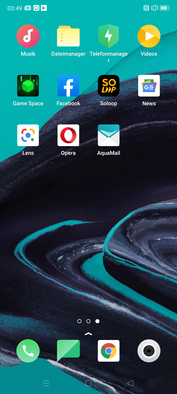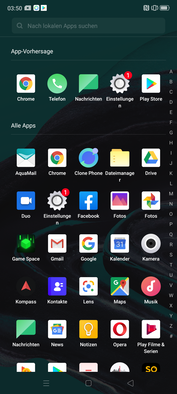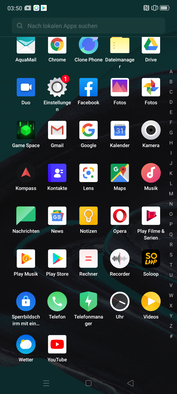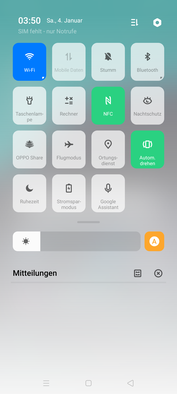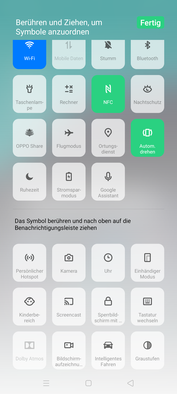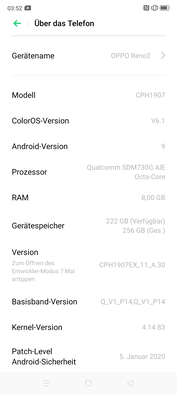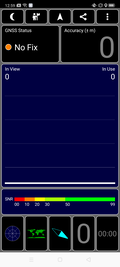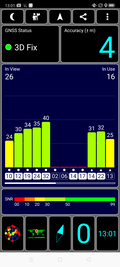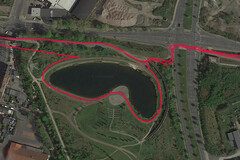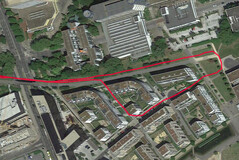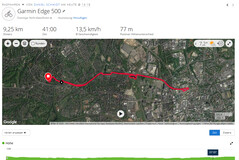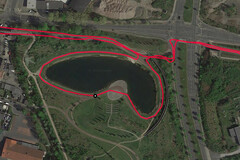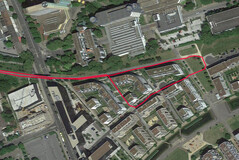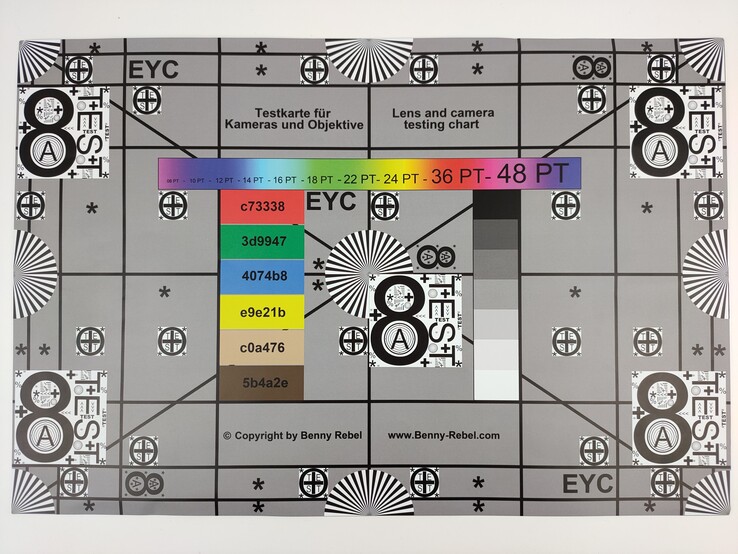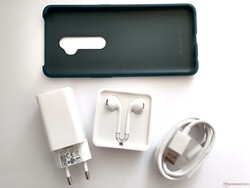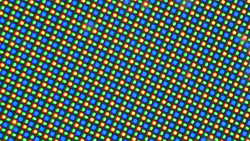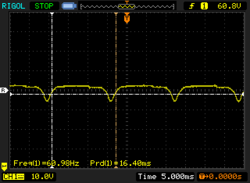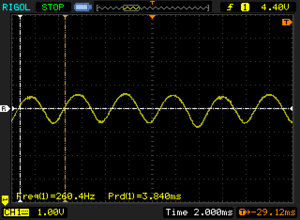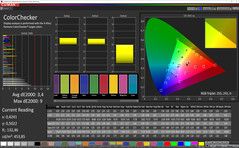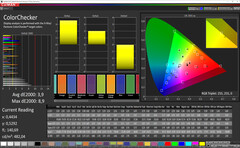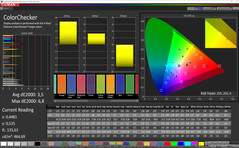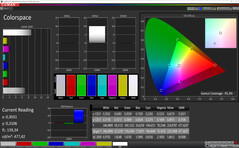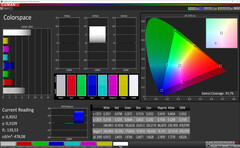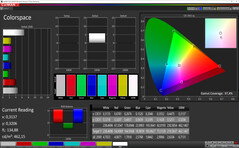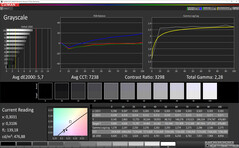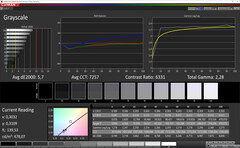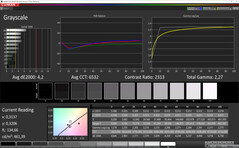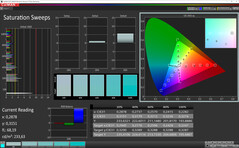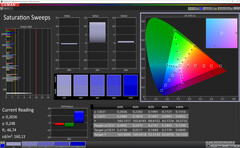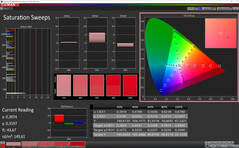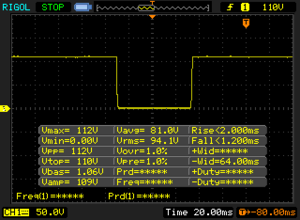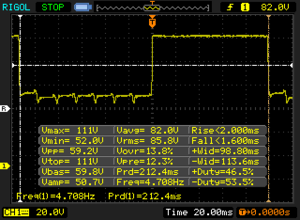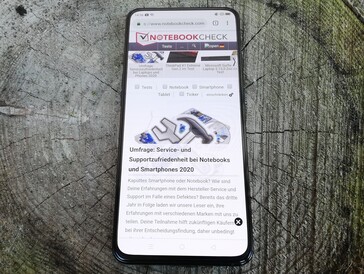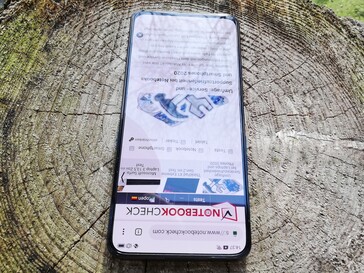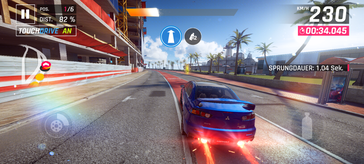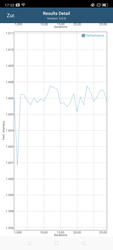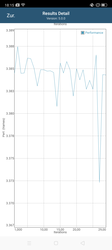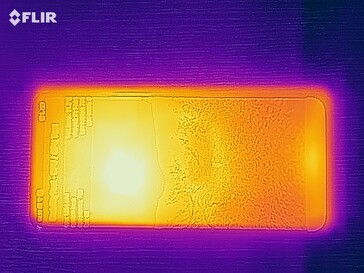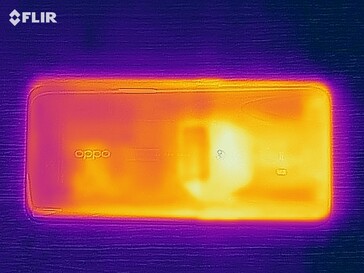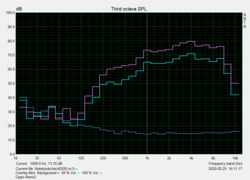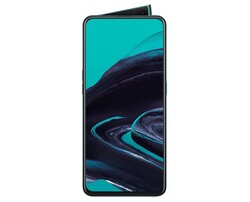Oppo Reno2 Smartphone in Review: Lackluster Camera Performance
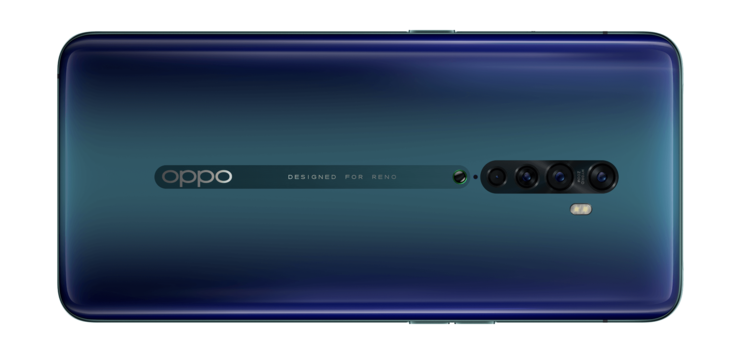
Thanks to the Oppo Reno2 Z, we have already been able to familiarize ourselves with the Chinese manufacturer's current smartphone lineup. The conclusion of the review was that while the smartphone is solid overall, it lacks polish. Meanwhile, the Oppo Reno2 belongs to a slightly more expensive price range and primarily tries to impress with its camera setup. With a Qualcomm Snapdragon 730G, Adreno 618 graphics, 8 GB of RAM, and 256 GB of UFS 2.1 storage, the hardware looks promising as well.
With this configuration, the Oppo Reno2 directly competes with the following competitors in our review. Additionally, other smartphones from our database can be added manually below the tables for comparison purposes.
Competing Devices
Rating | Date | Model | Weight | Drive | Size | Resolution | Price |
|---|---|---|---|---|---|---|---|
| 81.2 % v7 (old) | 03 / 2020 | Oppo Reno2 SD 730G, Adreno 618 | 189 g | 256 GB UFS 2.0 Flash | 6.50" | 2400x1080 | |
| 83.3 % v7 (old) | 12 / 2019 | Xiaomi Mi Note 10 SD 730G, Adreno 618 | 208 g | 128 GB UFS 2.0 Flash | 6.47" | 2340x1080 | |
| 85.8 % v7 (old) | 10 / 2019 | OnePlus 7T SD 855+, Adreno 640 | 190 g | 128 GB UFS 3.0 Flash | 6.55" | 2400x1080 | |
| 87.2 % v6 (old) | 07 / 2019 | Samsung Galaxy A80 SD 730, Adreno 618 | 220 g | 128 GB UFS 2.1 Flash | 6.70" | 2400x1080 | |
| 85.7 % v7 (old) | 07 / 2019 | LG G8s ThinQ SD 855, Adreno 640 | 181 g | 128 GB UFS 2.1 Flash | 6.20" | 2248x1080 |
Case - Solid Oppo Smartphone
The Oppo Reno2 comes with a glass back and a metal frame. The front is protected by Corning Gorilla Glass 6 and the Android smartphone looks well-built and robust overall. On top of that, the back features a visually very appealing color gradient for a stunning effect that changes depending on the angle at which light hits the surface of the phone. However, the Oppo Reno2 is generally very susceptible to fingerprints.
Compared to other smartphones in our comparison, the Oppo phone is one of the more lightweight devices and somewhere in the middle in terms of its size.
Features - Oppo Reno2 without Notification LED
Oppo has equipped the Reno2 with a Qualcomm Snapdragon 730G and an integrated Adreno 618 graphics unit. Combined with 8 GB of RAM and 256 GB of UFS 2.1 storage, the hardware configuration belongs to the upper mid-range. Furthermore, a microSD card reader is available for storage expansion, although an inserted memory card occupies the second nano-SIM slot. While both SIM slots support LTE, VoLTE or VoWiFi functionality is not available. Similarly, there is no notification LED.
Users have access to a USB Type-C port with an internal USB 2.0 standard interface for wired data transfer. Camera2 API level 3 is supported and streaming fans can enjoy Full HD content from services such as Netflix, Maxdome or Amazon Prime thanks to DRM Widevine L1.
Software - ColorOS with Up-to-Date Patches
The Oppo Reno2 greets its users with the ColorOS 6.1 UI. It is based on Android Pie and contains security patches from January 5, 2020. The navigation matches the stock Android system with only the symbols and the organization of the settings menu being different.
Aside from the apps that were customized by the manufacturer, a few third-party apps are also preinstalled on the Oppo Reno2. This includes Facebook, Opera, and AquaMail, all of which can be easily removed. At the time of this review, a February 2020 security patch update was already available.
Communication and GPS - Android Phone with NFC and LTE
The Oppo Reno2 can connect to GSM, 3G and LTE networks. Thanks to LTE Cat. 15, upload speeds of up to 300 Mb/s and download speeds of up to 800 Mb/s can be achieved.
Users also have access to NFC, Bluetooth and Wi-Fi for short-range wireless communication. The Wi-Fi module supports the Wi-Fi 5 standard and reaches very good transfer speeds of 618 Mb/s on average when receiving data from our reference router Netgear Nighthawk AX12. Meanwhile, the data transmission speeds are significantly slower at 355 Mb/s.
| Networking | |
| iperf3 transmit AX12 | |
| LG G8s ThinQ | |
| OnePlus 7T | |
| Oppo Reno2 | |
| Xiaomi Mi Note 10 | |
| Samsung Galaxy A80 | |
| iperf3 receive AX12 | |
| Oppo Reno2 | |
| LG G8s ThinQ | |
| OnePlus 7T | |
| Samsung Galaxy A80 | |
| Xiaomi Mi Note 10 | |
With the help of the GPS Test app, we tested the locating capabilities of the Oppo Reno2. The Android smartphone supports GPS, BeiDou, GLONASS and Galileo. Outdoors, the accuracy is within four meters, whereas our position could not be determined from the inside of buildings.
The Oppo phone shows mixed results when it comes to our obligatory bike ride. For example, it manages to keep up with our reference device Garmin Edge 500 at some route sections despite curves and buildings. However, there are also some major blackouts, where the recorded route significantly deviates from the actual track. This can be traced back to the aggressive energy-saver setting, which limits the use of the GPS despite a previously setup exception.
Telephony and Call Quality - Reno2 with Good Connection
Cameras - Reno2 with Impressive Selfie-Cam
At first glance, the camera setup of the Oppo Reno2 looks quite luxurious. There is a main camera with a 48 MP sensor and an f/1.7 aperture, 1/2.0 inches and a pixel width of 0.8 µm, a 13 MP telephoto lens with an f/2.4 aperture, 1/3.4 inches and a pixel width of 1.0 µm, an 8 MP ultra wide-angle lens with 1/3.2 inches, a pixel width of 1.4 µm as well as a 2 MP sensor for depth of field information with an f/2.4 aperture, 1/5 inches and a pixel width of 1.75 µm. The front camera can take pictures with its 16 MP sensor with an f/2.0 aperture and a pixel width of 1 µm. It is able to take pictures with good colors and many details. The borders of objects and fine structures are distinct from one another and only reveal a lack of sharpness at higher zoom levels. Users can only alter the final picture with a color filter or by activating a beauty mode. Additionally, the HDR mode can be enabled or disabled.
The quality of pictures taken with the main camera is average. Our panorama test scene was captured well and with vivid colors. While many details are present as well, they become less sharp even at lower zoom levels. Furthermore, the structures of uniform surfaces tend to blend together. The overall pictures fail to impress and lack clearly defined object boundaries. As for close range, many details and even fine patterns are captured well. Here, the colors are represented accurately as well. Meanwhile, our test image can still be made out in poor lighting conditions. However, colors are then too dark and the edges of the picture are completely black. Aside from an optical zoom with two steps and a hybrid zoom with five steps, the camera also offers a professional mode. It allows users to manually adjust the ISO value, shutter speed, focus, color balance and brightness.
The quality of video recordings is similar to the quality of our test images. For videos, users can choose between the modes 4K UHD at 30 FPS and 720p as well as 1080p at 30 or 60 FPS.
As the picture of the ColorChecker passport shows, the Oppo Reno2 consistently represents colors brighter than they are in reality. The image of our test chart further confirms this impression and exhibits paleness near the bottom corners. At a defined illumination of 1 lux, the content of the image can no longer be made out.
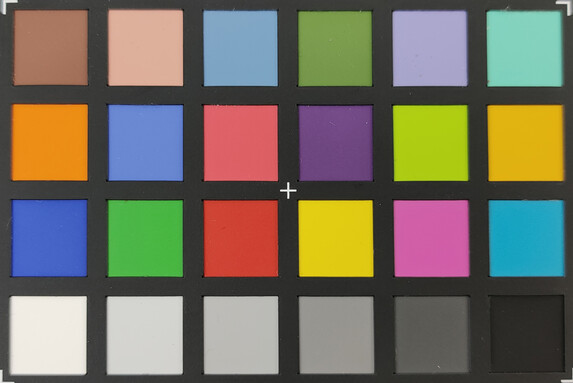

Accessories and Warranty - Protective Case and Headset Included
The Oppo Reno2's scope of delivery includes a USB charger with a suitable USB Type-C cable, a 3.5 mm stereo headset, a SIM needle and a protective case. The latter has an attractive faux-leather look and appears much higher in terms of quality than the simple, complimentary silicone shells that other manufacturers often include.
Oppo offers a 24-month warranty period to buyers of the Reno2.
Input Devices & Handling - Good Touchscreen and Distinct Feedback
Oppo relies on Google's default keyboard app GBoard for text inputs. It has many customization options and is suitable for typing longer texts. The touchscreen responds very reliably to inputs and the optional vibration provides a pleasant feedback. Thanks to the smooth surface, drag and drop operations are easy to perform as well.
Oppo has equipped its phone with an in-screen fingerprint sensor for unlocking purposes. However, it responded very unreliably to stored fingerprints in our test. Users may also choose facial recognition, which generally works well. Since the front camera is embedded in the case, the latter option requires activating the display with the power button, after which the camera button in the bottom right corner can be pressed. Subsequently, the camera temporarily pops up, identifies the face and unlocks the phone. Simply entering a PIN is a faster option.
Display - Oppo Reno2 with Disruptive PWM
The screen of the Oppo Reno2 consists of a 6.5-inch OLED panel with a resolution of 2400x1080 pixels. Meanwhile, 683 cd/m² on average represents the second highest brightness in our comparison. Without the ambient light sensor, we only measured 484 cd/m², while 904 cd/m² was reached in the APL50 test, which is a very good result.
Oppo uses two methods to control the brightness. In bright environments or during the day, PWM with a fairly low frequency of 260 Hz is active at less than 99% brightness. According to the manufacturer, a night mode that is not described in more detail uses DC dimming and PWM at a frequency of 60 Hz. We advise against this display for users with sensitive eyes, since the PWM flickering is very noticeable. However, there is a "flicker free backlight dimming" menu entry that when enabled results in a far more enjoyable image.
| |||||||||||||||||||||||||
Brightness Distribution: 98 %
Center on Battery: 679 cd/m²
Contrast: ∞:1 (Black: 0 cd/m²)
ΔE ColorChecker Calman: 3.5 | ∀{0.5-29.43 Ø4.78}
ΔE Greyscale Calman: 4.2 | ∀{0.09-98 Ø5}
95.3% sRGB (Calman 2D)
Gamma: 2.27
CCT: 6532 K
| Oppo Reno2 AMOLED, 2400x1080, 6.5" | Xiaomi Mi Note 10 AMOLED, 2340x1080, 6.5" | OnePlus 7T AMOLED, 2400x1080, 6.6" | Samsung Galaxy A80 AMOLED, 2400x1080, 6.7" | LG G8s ThinQ P-OLED, 2248x1080, 6.2" | |
|---|---|---|---|---|---|
| Screen | -9% | 6% | -9% | -2% | |
| Brightness middle (cd/m²) | 679 | 625 -8% | 693 2% | 478 -30% | 539 -21% |
| Brightness (cd/m²) | 683 | 607 -11% | 703 3% | 486 -29% | 556 -19% |
| Brightness Distribution (%) | 98 | 89 -9% | 96 -2% | 96 -2% | 88 -10% |
| Black Level * (cd/m²) | |||||
| Colorchecker dE 2000 * | 3.5 | 4.38 -25% | 3.42 2% | 2.97 15% | 3.78 -8% |
| Colorchecker dE 2000 max. * | 6.8 | 6.83 -0% | 6.12 10% | 10.18 -50% | 6.95 -2% |
| Greyscale dE 2000 * | 4.2 | 4.1 2% | 3.3 21% | 2.5 40% | 2.2 48% |
| Gamma | 2.27 97% | 2.251 98% | 2.265 97% | 2.031 108% | 2.274 97% |
| CCT | 6532 100% | 7251 90% | 6799 96% | 6533 99% | 6013 108% |
* ... smaller is better
Screen Flickering / PWM (Pulse-Width Modulation)
| Screen flickering / PWM detected | 260.4 Hz | ≤ 99 % brightness setting | |
The display backlight flickers at 260.4 Hz (worst case, e.g., utilizing PWM) Flickering detected at a brightness setting of 99 % and below. There should be no flickering or PWM above this brightness setting. The frequency of 260.4 Hz is relatively high, so most users sensitive to PWM should not notice any flickering. However, there are reports that some users are still sensitive to PWM at 500 Hz and above, so be aware. In comparison: 53 % of all tested devices do not use PWM to dim the display. If PWM was detected, an average of 8101 (minimum: 5 - maximum: 343500) Hz was measured. | |||
In typical OLED-fashion, the display of the Oppo Reno2 offers a very high contrast ratio. Colors are very distinct from one another and black image content is achieved by switching off pixels. At 95% (sRGB), the color-space coverage is very good as well. Additionally, the Reno2 is able to display 97% of the larger DCI-P3 color space, when the appropriate profile is selected.
Users can alter the color representation through the menu of the Reno2. Here, various modes are available. The blue portion is slightly too high and the contrast ratio comparatively low on the standard setting. While the increased blue portion remains in the vivid mode, colors appear much more pronounced thanks to a higher contrast ratio. The balanced mode reduces the blue portion, resulting in a significantly warmer color temperature.
Display Response Times
| ↔ Response Time Black to White | ||
|---|---|---|
| 3.2 ms ... rise ↗ and fall ↘ combined | ↗ 2 ms rise | |
| ↘ 1.2 ms fall | ||
| The screen shows very fast response rates in our tests and should be very well suited for fast-paced gaming. In comparison, all tested devices range from 0.1 (minimum) to 240 (maximum) ms. » 13 % of all devices are better. This means that the measured response time is better than the average of all tested devices (20.2 ms). | ||
| ↔ Response Time 50% Grey to 80% Grey | ||
| 3.6 ms ... rise ↗ and fall ↘ combined | ↗ 2 ms rise | |
| ↘ 1.6 ms fall | ||
| The screen shows very fast response rates in our tests and should be very well suited for fast-paced gaming. In comparison, all tested devices range from 0.165 (minimum) to 636 (maximum) ms. » 13 % of all devices are better. This means that the measured response time is better than the average of all tested devices (31.6 ms). | ||
Performance - Reno2 with Good System Performance
The performance of the Oppo Reno2 can be described as upper mid-range thanks to the Qualcomms Snapdragon 730G. Combined with the Qualcomm Adreno 618 graphics unit and 8 GB of RAM, most daily tasks should be trivial to perform.
In our benchmark tests, the Reno2 tends to be below average compared to the other devices in our comparison. While it is able to outperform the Xiaomi Mi Note 10 occasionally when it comes to system-heavy workloads, it often falls behind in graphics-heavy tests. During our review, the system was always smooth and did not suffer from micro stutters.
| PCMark for Android | |
| Work performance score (sort by value) | |
| Oppo Reno2 | |
| Xiaomi Mi Note 10 | |
| OnePlus 7T | |
| Samsung Galaxy A80 | |
| LG G8s ThinQ | |
| Average Qualcomm Snapdragon 730G (8941 - 10200, n=7) | |
| Work 2.0 performance score (sort by value) | |
| Oppo Reno2 | |
| Xiaomi Mi Note 10 | |
| OnePlus 7T | |
| Samsung Galaxy A80 | |
| LG G8s ThinQ | |
| Average Qualcomm Snapdragon 730G (7134 - 8683, n=7) | |
| GFXBench 3.0 | |
| on screen Manhattan Onscreen OGL (sort by value) | |
| Oppo Reno2 | |
| Xiaomi Mi Note 10 | |
| OnePlus 7T | |
| Samsung Galaxy A80 | |
| LG G8s ThinQ | |
| Average Qualcomm Snapdragon 730G (25 - 39, n=6) | |
| Average of class Smartphone (18 - 166, n=157, last 2 years) | |
| 1920x1080 1080p Manhattan Offscreen (sort by value) | |
| Oppo Reno2 | |
| Xiaomi Mi Note 10 | |
| OnePlus 7T | |
| Samsung Galaxy A80 | |
| LG G8s ThinQ | |
| Average Qualcomm Snapdragon 730G (41 - 42, n=6) | |
| Average of class Smartphone (12 - 606, n=156, last 2 years) | |
| GFXBench 3.1 | |
| on screen Manhattan ES 3.1 Onscreen (sort by value) | |
| Oppo Reno2 | |
| Xiaomi Mi Note 10 | |
| OnePlus 7T | |
| Samsung Galaxy A80 | |
| LG G8s ThinQ | |
| Average Qualcomm Snapdragon 730G (16 - 29, n=6) | |
| Average of class Smartphone (11 - 166, n=157, last 2 years) | |
| 1920x1080 Manhattan ES 3.1 Offscreen (sort by value) | |
| Oppo Reno2 | |
| Xiaomi Mi Note 10 | |
| OnePlus 7T | |
| Samsung Galaxy A80 | |
| LG G8s ThinQ | |
| Average Qualcomm Snapdragon 730G (30 - 30, n=6) | |
| Average of class Smartphone (8.4 - 413, n=156, last 2 years) | |
| AnTuTu v8 - Total Score (sort by value) | |
| Oppo Reno2 | |
| Xiaomi Mi Note 10 | |
| LG G8s ThinQ | |
| Average Qualcomm Snapdragon 730G (251673 - 275660, n=6) | |
In the browser benchmarks the Oppo Reno2's results are mixed, although compared to other devices in our comparison, it still offers an average performance level. The browser is smooth during daily use and multimedia content loads quickly.
| Jetstream 2 - 2.0 Total Score | |
| Average of class Smartphone (23.8 - 387, n=149, last 2 years) | |
| OnePlus 7T (Chrome 76) | |
| LG G8s ThinQ (Chrome 75) | |
| Average Qualcomm Snapdragon 730G (45.8 - 50.6, n=6) | |
| Xiaomi Mi Note 10 (Chrome 78) | |
| Oppo Reno2 (Chrome 80) | |
| Samsung Galaxy A80 (Chrome 75) | |
| JetStream 1.1 - Total Score | |
| OnePlus 7T (Chrome 76) | |
| LG G8s ThinQ (Chrome 75) | |
| Oppo Reno2 (Chrome 80) | |
| Average Qualcomm Snapdragon 730G (79.2 - 87.7, n=6) | |
| Xiaomi Mi Note 10 (Chrome 78) | |
| Samsung Galaxy A80 (Chrome 75) | |
| Speedometer 2.0 - Result 2.0 | |
| Average of class Smartphone (15.2 - 643, n=122, last 2 years) | |
| OnePlus 7T (Chome 76) | |
| LG G8s ThinQ (Chome 75) | |
| Oppo Reno2 (Chrome 80) | |
| Xiaomi Mi Note 10 (Chrome 78) | |
| Average Qualcomm Snapdragon 730G (40.4 - 44.2, n=6) | |
| Samsung Galaxy A80 (Chome 75) | |
| WebXPRT 3 - Overall | |
| Average of class Smartphone (38 - 380, n=31, last 2 years) | |
| LG G8s ThinQ (Chrome 75) | |
| OnePlus 7T (Chrome 76) | |
| Samsung Galaxy A80 (Chrome 75) | |
| Xiaomi Mi Note 10 (Chrome 78) | |
| Average Qualcomm Snapdragon 730G (66 - 77, n=6) | |
| Oppo Reno2 (Chrome 80) | |
| Octane V2 - Total Score | |
| Average of class Smartphone (2228 - 121337, n=197, last 2 years) | |
| OnePlus 7T (Chrome 76) | |
| LG G8s ThinQ (Chrome 75) | |
| Oppo Reno2 (Chrome 80) | |
| Average Qualcomm Snapdragon 730G (16197 - 17768, n=6) | |
| Samsung Galaxy A80 (Chrome 75) | |
| Xiaomi Mi Note 10 (Chrome 78) | |
| Mozilla Kraken 1.1 - Total | |
| Oppo Reno2 (Chrome 80) | |
| Samsung Galaxy A80 (Chrome 75) | |
| Average Qualcomm Snapdragon 730G (2770 - 3054, n=6) | |
| Xiaomi Mi Note 10 (Chrome 78) | |
| LG G8s ThinQ (Chrome 75) | |
| OnePlus 7T (Chrome 76) | |
| Average of class Smartphone (257 - 28190, n=154, last 2 years) | |
* ... smaller is better
The Oppo smartphone has 256 GB of storage space. Although the manufacturer has specified UFS 2.1 storage, the read and write speeds indicate UFS 2.0 memory. In our memory benchmark, it achieves below average read and write speeds. That being said, the mediocre results do not manifest in any noticeable disadvantages during day-to-day use.
The memory of the Android phone can be expanded with a microSD card, although in doing so, the dual-SIM functionality is lost. According to the manufacturer, cards with a capacity of up to 256 GB can be used. The transfer speeds with our reference memory card Toshiba Exceria Pro M501 are slightly below average. Reformatting the card to internal storage is not possible; apps also cannot be transferred to the microSD card.
| Oppo Reno2 | Xiaomi Mi Note 10 | OnePlus 7T | Samsung Galaxy A80 | LG G8s ThinQ | Average 256 GB UFS 2.0 Flash | Average of class Smartphone | |
|---|---|---|---|---|---|---|---|
| AndroBench 3-5 | 109% | 66% | -5% | 11% | 32% | 685% | |
| Sequential Read 256KB (MB/s) | 469.3 | 480.5 2% | 1406 200% | 502 7% | 791 69% | 484 ? 3% | 2228 ? 375% |
| Sequential Write 256KB (MB/s) | 201.8 | 243.6 21% | 218.4 8% | 190.4 -6% | 182.4 -10% | 203 ? 1% | 1852 ? 818% |
| Random Read 4KB (MB/s) | 144.2 | 106.2 -26% | 170.1 18% | 117.5 -19% | 138 -4% | 131.7 ? -9% | 296 ? 105% |
| Random Write 4KB (MB/s) | 22 | 118.9 440% | 29.9 36% | 21.6 -2% | 29.6 35% | 65.3 ? 197% | 339 ? 1441% |
| Sequential Read 256KB SDCard (MB/s) | 74.5 ? | 67.5 ? -9% | 74.5 ? 0% | ||||
| Sequential Write 256KB SDCard (MB/s) | 53.5 ? | 46.7 ? -13% | 53.5 ? 0% |
Gaming - Gaming-capable Smartphone from Oppo
The integrated graphics unit Qualcomm Adreno 618 allows users of the Oppo Reno2 to smoothly run current games. Arena of Valor and Asphalt 9: Legends, both of which were tested with Gamebench, ran completely stutter-free even at high graphics settings. Meanwhile, the touchscreen controls are responsive and reliable and the gyroscope lends itself well to gaming controls.
Arena of Valor
Asphalt 9: Legends
Emissions - Phone with Good Speakers
Temperature
According to our measurements, the Oppo Reno2 reaches surface temperatures of around 25 °C during idle and up to 33.5 °C under load. As a result, there is not a lot of heat development and the smartphone can be comfortably held. Furthermore, the two GFXBench long-term stress tests Manhattan 3.1 and ES 2.0 show the Android smartphone to be incapable of maintaining its performance for prolonged periods of time.
(+) The maximum temperature on the upper side is 33.5 °C / 92 F, compared to the average of 35.2 °C / 95 F, ranging from 21.9 to 247 °C for the class Smartphone.
(+) The bottom heats up to a maximum of 30.9 °C / 88 F, compared to the average of 34 °C / 93 F
(+) In idle usage, the average temperature for the upper side is 25.3 °C / 78 F, compared to the device average of 32.9 °C / 91 F.
Speaker
The speaker of the Oppo Reno2 offers a fairly high maximum volume and a sound that's centered on higher mids. Lower frequencies are present as well for a relatively full sound. Thus, the smartphone is well-suited to multimedia playback, although the audio experience becomes distorted at higher volumes.
Headphones or external speakers can be connected via a 3.5 mm jack, which firmly holds plugs while not negatively impacting the sound.
Oppo Reno2 audio analysis
(+) | speakers can play relatively loud (87.5 dB)
Bass 100 - 315 Hz
(-) | nearly no bass - on average 26.3% lower than median
(±) | linearity of bass is average (13.2% delta to prev. frequency)
Mids 400 - 2000 Hz
(+) | balanced mids - only 4.7% away from median
(+) | mids are linear (3.7% delta to prev. frequency)
Highs 2 - 16 kHz
(±) | higher highs - on average 7.7% higher than median
(+) | highs are linear (3.2% delta to prev. frequency)
Overall 100 - 16.000 Hz
(±) | linearity of overall sound is average (21.6% difference to median)
Compared to same class
» 43% of all tested devices in this class were better, 8% similar, 50% worse
» The best had a delta of 11%, average was 35%, worst was 134%
Compared to all devices tested
» 60% of all tested devices were better, 7% similar, 33% worse
» The best had a delta of 4%, average was 24%, worst was 134%
Xiaomi Mi Note 10 audio analysis
(+) | speakers can play relatively loud (83.6 dB)
Bass 100 - 315 Hz
(-) | nearly no bass - on average 69.6% lower than median
(+) | bass is linear (0% delta to prev. frequency)
Mids 400 - 2000 Hz
(-) | nearly no mids - on average 69.6% lower than median
(+) | mids are linear (0% delta to prev. frequency)
Highs 2 - 16 kHz
(-) | nearly no highs - on average 69.6% lower than median
(+) | highs are linear (0% delta to prev. frequency)
Overall 100 - 16.000 Hz
(-) | overall sound is not linear (119.9% difference to median)
Compared to same class
» 89% of all tested devices in this class were better, 8% similar, 3% worse
» The best had a delta of 11%, average was 35%, worst was 134%
Compared to all devices tested
» 97% of all tested devices were better, 3% similar, 1% worse
» The best had a delta of 4%, average was 24%, worst was 134%
Battery Life - Disappointing for a 4,000 mAh Battery
Energy Consumption
Compared to most of the other devices we selected, the Reno2's average energy consumption is lower. Under maximum load for example, the Oppo smartphone was the most economical device in our comparison.
| Off / Standby | |
| Idle | |
| Load |
|
Key:
min: | |
| Oppo Reno2 4000 mAh | Xiaomi Mi Note 10 5260 mAh | OnePlus 7T 3800 mAh | Samsung Galaxy A80 3700 mAh | LG G8s ThinQ 3550 mAh | Average Qualcomm Snapdragon 730G | Average of class Smartphone | |
|---|---|---|---|---|---|---|---|
| Power Consumption | -23% | -33% | 3% | -38% | -25% | -31% | |
| Idle Minimum * (Watt) | 0.7 | 0.7 -0% | 0.9 -29% | 0.6 14% | 1.2 -71% | 0.84 ? -20% | 0.842 ? -20% |
| Idle Average * (Watt) | 1.25 | 1.8 -44% | 1.4 -12% | 1.2 4% | 1.6 -28% | 1.953 ? -56% | 1.439 ? -15% |
| Idle Maximum * (Watt) | 1.36 | 2.2 -62% | 2.9 -113% | 1.4 -3% | 2 -47% | 2.26 ? -66% | 1.624 ? -19% |
| Load Average * (Watt) | 5.38 | 5.2 3% | 4.7 13% | 5 7% | 5 7% | 4.51 ? 16% | 7.03 ? -31% |
| Load Maximum * (Watt) | 6.71 | 7.5 -12% | 8.3 -24% | 7.1 -6% | 10 -49% | 6.63 ? 1% | 11.3 ? -68% |
* ... smaller is better
Battery Life
Although at 4,000 mAh, the Reno2's battery capacity is high, the smartphone does not do a very good job at taking advantage of it. While just above 10 hours in our real-world Wi-Fi test is far from a poor result, some competitors in our comparison manage to outlast our test device in spite of having a significantly smaller battery.
The included quick charger is rated for 20 watts and able to fully recharge the battery within about 1.5 hours.
| Oppo Reno2 4000 mAh | Xiaomi Mi Note 10 5260 mAh | OnePlus 7T 3800 mAh | Samsung Galaxy A80 3700 mAh | LG G8s ThinQ 3550 mAh | |
|---|---|---|---|---|---|
| Battery runtime | 51% | 16% | -7% | -11% | |
| Reader / Idle (h) | 42.2 | 35.6 -16% | 33.4 -21% | 29.9 -29% | 28.2 -33% |
| H.264 (h) | 18.8 | 23.7 26% | 16.1 -14% | 15 -20% | 12.6 -33% |
| WiFi v1.3 (h) | 10.3 | 18.8 83% | 14.9 45% | 11.9 16% | 11.6 13% |
| Load (h) | 3.1 | 6.5 110% | 4.7 52% | 3.3 6% | 3.4 10% |
Pros
Cons
Verdict - Oppo Reno2 Lacks Polish
Our feelings about the Oppo Reno2 are mixed. On the one hand, it has a premium look and the handling as well as the hardware performance during day-to-day use is very good. On the other hand, a closer look reveals a rather mediocre camera, which essentially only consists of four individual sensors for different scenarios, and a relatively short runtime despite of the large battery. Additionally, users with sensitive eyes will not be able to enjoy the display for prolonged periods of time.
Although buyers of the Oppo Reno2 won't be investing in a bad phone, the quad-camera system should not be the deciding factor.
The Oppo Reno2's selfie cam, which pops up automatically, is a handy feature that primarily grants users more screen estate. As a result, neither a notch nor a punch hole disrupts the displayed content. On top of that, the front camera takes very good pictures and even somewhat takes away the spotlight from the main camera. Thus, prospective buyers would be well-advised to consider their personal expectations to see if they align with the strengths and weaknesses of the Reno2 in order to avoid being disappointed in the end.
Oppo Reno2
- 09/03/2022 v7 (old)
Mike Wobker




